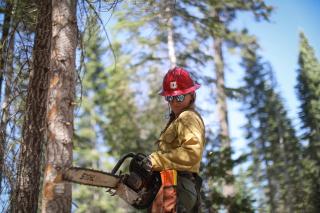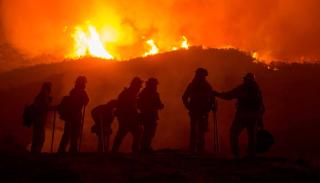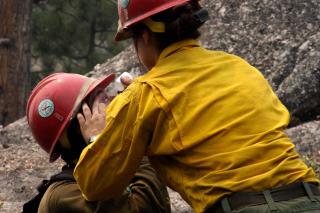
Fighting wildland fire, running whitewater rapids, using heavy machinery, interacting with wildlife, and parachuting into rugged terrain. Depending on the career, these are just some of the exciting experiences that USDA Forest Service employees may have on any given day. However, they often take place in remote locations where you quickly realize the last thing you want is an injury and the last thing you need are drugs or alcohol.
According to the National Safety Council, the third most dangerous industry category in the nation is the one that includes agriculture, forestry, fishing and hunting. This industry category also has the highest death rate per 100,000 workers. Four hundred (18.2 percent per 100,000 workers) of these fatal injuries were preventable.

Safety From Day Zero
When thinking about workplace safety we often first think of the higher-risk blue-collar professions who typically work out in the field. However, even working from inside behind a computer, safety is at the forefront of the mind of each specialist on the Forest Service national drug testing team.
“Safety is one of our agency’s core values. We’re anchored to that. We know that working for the Forest Service can be dangerous, and we take our role in supporting a healthy and safe work environment seriously,” said national drug testing program supervisor Angelica Sierra.
Supporting an agency of over 30,000 employees, Angelica’s team is busy, averaging more than 700 drug tests per month. Most of these tests are for preemployment requirements.
“Preemployment drug tests are intended to screen out applicants who use illegal substances. Every day is different, and we just never know what we are going to encounter,” said specialist Brenda Rodriguez.

Not all applicants are tested for drug use, only those with a “test designated position,” such as public health and safety jobs like law enforcement, firefighting and those that need commercial drivers’ licenses.
A positive test result disqualifies an applicant from joining the Forest Service for at least six months.
“About 2% test positive for illegal drugs. Most commonly it’s marijuana, cocaine, or unauthorized prescription drugs. A lot of times, people are surprised by the fact that some of these drugs are still illegal. Currently there’s a disconnect between state and federal marijuana laws,” said program coordinator Dawn Cordova.
Just a reminder: It’s still illegal for federal employees to use marijuana, despite any state law that allows it.

Balancing Safety, Hiring Timelines and Workloads
The tests are just one of many tasks certain employees must complete during the onboarding process when starting a new Forest Service career.
“A large part of our workload is coordinating with applicants, supervisors, and others to make sure things go smoothly and that people start on time. This is a rewarding place to work. We get to interface with employees across the country, but safety and readiness are always on our minds,” said specialist Ryan Johnson.
The drug testing process can affect the hiring timeline which can in turn have significant impacts on critical work across the country. On average the testing process takes around two weeks, while the full onboarding process takes about two months. However, making sure employees start on time is a priority for the agency, and that includes the drug testing team.
“If the hiring process takes longer, and an employee misses a training for a required certification, this can negatively affect the local unit,” said specialist Janice Baca-Valdez.
When asked about the timing of onboarding employees, Rio Grande National Forest Supervisor Dennis Kuhnel shared that when it comes down to completing the mission, it’s critical that new employees start on schedule. “We feel the consequences when timelines are not favorable,” said Kuhnel.
The agency has streamlined hiring processes significantly throughout the past few years. Processes that previously could only happen one at a time can now occur simultaneously due to the development and implementation of new processing software.

In addition to pre-employment tests, the team also manages other tests for certain current employees. These include random tests, tests after accidents, and tests due to reasonable suspicion.
Boots on the Ground
Mitigating the additional risks of drug and alcohol use is not lost on wildland firefighters and emergency personnel who don’t only need to watch their own safety, but also for the safety of their coworkers.
“There are many hazards associated with the work the boots on the ground face, including many human factors that can influence decisions out in the field, like fatigue, complacency and more. The last thing we need is additional influences like drugs or alcohol to impede timely responses to identify hazards with clear focus or impede risk informed decisions that affect the safety of others. Interdependence and safety are core values we practice daily. The agency’s drug testing program supports that” said Tim Sampson, Risk Management Officer for the National Incident Management Organization.

When asked about the program’s impacts to boots on the ground, specialist Jesse Noga recalls his time in the infantry. “When your safety can rely on the person to the left of you and the person to the right, you need them to be sharp,” said Noga.
“Smokejumpers, equipment operators, everyone involved. This can be our employees, the public, or our partners. We do our part to keep them safe,” said drug testing specialist Renee Gallegos.
Safety Impacts Across the Nation
“Personnel operating equipment while under the influence of prescription, non-prescription, or other illegal drugs not only endangers other employees, but also the safety of the visiting public,” said Monte Ulmer, director of the Office of Safety and Occupational Health.
Ulmer knows that Forest Service employees are held to higher standards of safety. “Good order and discipline are paramount as they have the responsibility of safely managing our nation’s forests; looking out for fellow employees when conducting remediation operations; and ensuring the visiting public is safe. That is a huge responsibility we do not take lightly,” he explained.
Having a drug-free environment also improves productivity due to decreases in absenteeism, downtime, turnover, theft and on-the-job injuries. Agency worker’s compensation costs have decreased over the past two decades from $29.9 million in 2017 to $19.7 million in 2022. This shows leaders at all levels are staying vigilant to changing conditions and managing risks in agency operating environments.
Whether the job is in human resources or wildland firefighting, or anywhere from Washington D.C. to Washington State, the importance of safety is a consistent echo across the agency, beginning with a small but mighty team of 12 drug testing specialists.
Substance Abuse Support
Dealing with substance abuse goes beyond just catching people, it also means providing resources to support people grappling with substance abuse.
“We’re not ‘out to get’ anyone,” said specialist Estrella Soliz-Gomez. “We are here to help people and we are a resource that can point employees in the right direction when they may need it most.”

The specialists of the drug testing program serve as liaisons for employees who would like to use the Safe Harbor program for help with substance abuse. The Safe Harbor program is one of several employee support programs available for current agency employees. It creates a “safe harbor” from disciplinary action for current employees who:
Voluntarily admit illegal drug use to supervisors or management officials or volunteer for drug testing before being identified by other means, and
Obtain and complete counseling and rehabilitation through the Employee Assistance Program and,
Subsequently refrain from illegal drug use.
The team also offers training to supervisors about policy and how to identify signs of substance abuse.
If you are an employee or know an employee who needs help or information about substance abuse, please contact the Forest Service Employee Assistance Program.
Editor’s Note: Want to learn more about the Drug Testing Program and what it’s like to be on the team? Hear from the team about the value they feel for their work in their own words!





